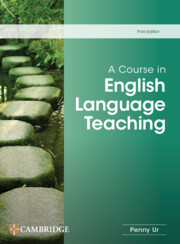Book contents
- Frontmatter
- Contents
- Acknowledgements
- Introduction
- 1 Teaching English today
- 2 The lesson
- 3 Classroom interaction
- 4 Tasks
- 5 Texts
- 6 Teaching vocabulary
- 7 Teaching grammar
- 8 Teaching listening
- 9 Teaching speaking
- 10 Teaching reading
- 11 Teaching writing
- 12 Feedback and error correction
- 13 Assessment and testing
- 14 The syllabus
- 15 Teaching/learning materials
- 16 Teaching content
- 17 Classroom discipline
- 18 Digital technology and online teaching
- 19 Learner differences 1: age
- 20 Learner differences 2: diversity and inclusion
- 21 Teacher development
- Glossary
- References
- Index
15 - Teaching/learning materials
Published online by Cambridge University Press: 15 March 2024
- Frontmatter
- Contents
- Acknowledgements
- Introduction
- 1 Teaching English today
- 2 The lesson
- 3 Classroom interaction
- 4 Tasks
- 5 Texts
- 6 Teaching vocabulary
- 7 Teaching grammar
- 8 Teaching listening
- 9 Teaching speaking
- 10 Teaching reading
- 11 Teaching writing
- 12 Feedback and error correction
- 13 Assessment and testing
- 14 The syllabus
- 15 Teaching/learning materials
- 16 Teaching content
- 17 Classroom discipline
- 18 Digital technology and online teaching
- 19 Learner differences 1: age
- 20 Learner differences 2: diversity and inclusion
- 21 Teacher development
- Glossary
- References
- Index
Summary
The coursebook: approach, components, presentation
The most common type of teaching/learning materials used in English teaching worldwide is the coursebook or textbook. Here, I’ll make a distinction between these two terms. Coursebook will be used to designate the book that covers all the texts, tasks and language points that will be taught in a course. Textbook, in contrast, is a more general term: it could refer to a coursebook, but could also be a book of grammar exercises, or of reading texts with comprehension questions.
Both are most frequently used in the form of conventional paper books. Online or digital course materials are on the increase, but the evidence is that a substantial majority of students prefer paper textbooks, at least at university level (Baron et al., 2017), and this may well be true of younger students as well.
Approach
A coursebook follows – or sometimes only claims to follow – a certain approach to language teaching and learning, leading to a preferred methodology, which is often explained in the introduction or the blurb on the back cover. This approach may or may not be implemented in the content of the book. For example, many modern coursebooks claim to follow the communicative approach, but in fact much, if not most, of their space is taken up with activities whose main aim is getting the language right – vocabulary, grammar and pronunciation – rather than engaging learners in communicative tasks.
Components
The main components in any coursebook are:
• the syllabus, usually laid out as a table of contents at the beginning; • reading and listening texts with following comprehension work;
• writing and speaking tasks;
• explanations of language points (usually grammar);
• grammar and vocabulary exercises;
• lists of new vocabulary.
It may also provide:
• transcripts of listening comprehension texts;
• a glossary of vocabulary items at the end of the book;
• tests;
• extra practice exercises on grammar and vocabulary, (sometimes in a separate workbook);
• a teacher's book, or teacher's guide, in a separate book;
• a website, with further guidance or materials.
Presentation
An important aspect of the coursebook is how it is presented: what the page looks like, how easy it is to identify headings and navigate to different pages and texts. Most coursebooks these days are full colour, with plenty of pictures. Pages are often divided into two columns in order to get as much material as possible on each page.
- Type
- Chapter
- Information
- A Course in English Language Teaching , pp. 204 - 220Publisher: Cambridge University PressPrint publication year: 2024



